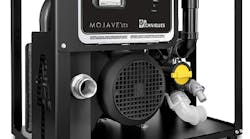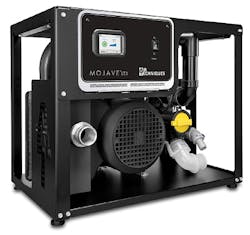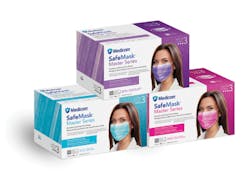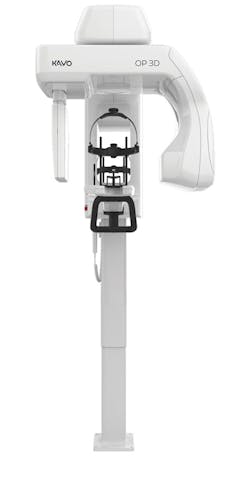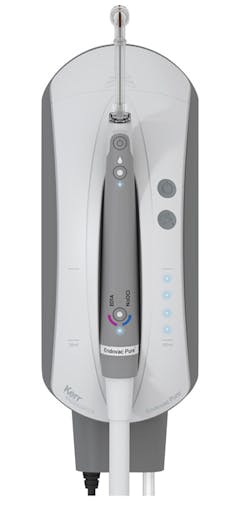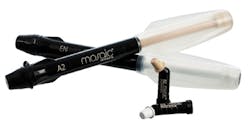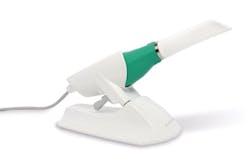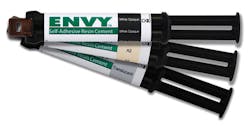Products to See at the Greater New York Dental Meeting
Meeting dates: Nov. 24–29 | Exhibit dates: Nov. 26–29
Product spotlight by Pamela Maragliano-Muniz, DMD
Interview with Gregory Kass, product manager, Air Techniques
Mojave LT 3 dry vacuum system
Company | Air Techniques |
Greater New York booth No. | 3401 |
More information | airtechniques.com |
Traditional suction systems tend to be loud and take up a considerable amount of space. How do Mojave dry vacuum systems differ?
Our Mojave high-powered vacuum systems utilize no oil or water in order to generate high-powered suction. Only a small amount of water is used in the tank to allow for material washout. This, combined with an energy variable-frequency-driven motor (VFD), makes this the most environmentally friendly system with the lowest maintenance. It can significantly reduce the amount of energy and utilities that are used in a dental practice.
Can you tell us more about VFD?
The speed of a VFD system will vary depending on how many HVEs (high speed suctions) are going at one time. Traditional systems run at the same power regardless of how many operatories are in use. This system uses the appropriate amount of energy depending on the needs of the practice. If one or two operatories are in use, less power and energy are needed than if four or more operatories were in use at the same time.
There are a few models of Mojave available. What are some new features of the Mojave LT 3?
Our Mojave LT 3 offers the same high-powered VFD of the Mojave V3 system, but it offers a significant quieter noise output, smaller footprint, and a more attractive price point. It has a lot of space-saving versatility—the Mojave LT 3 can be placed into a closet or even inside a cabinet.
The Mojave LT 3 also offers a multicolored touch-screen display that includes “smart alarms.” These alarms keep the dental office staff and technicians up-to-date on the status of the system. The machine will warn you if the pump or separator requires maintenance, and an error alarm will alert you if there is an issue with the system.
The Mojave LT 3 is also compatible with NEO Pulse Software, a free software program that is downloadable to a desktop computer or a handheld device running Windows. NEO Pulse Software transfers alerts from the touch screen to a separate device, so these alerts can notify office staff without them having to walk into the utility room. The software can create a maintenance schedule and share vital statistics with a technician remotely via a team viewer, so the technician can prepare ahead of time. This reduces the time, number, and ultimately cost of technician visits.
When an office experiences a suction system failure, a dentist may decide to purchase a system that will get the practice up and running as quickly as possible, without considering the features or benefits from available systems. Can you offer dentists advice to minimize the risk of suction system failure, which may result in an impulse purchase?
Most suction systems last approximately 10 years. If your system is reaching that 10-year mark, it may be wise to start looking at available systems and consider an upgrade. Also, look at your utility bills. If you are seeking to reduce utility costs, a system that eliminates the need for oil and minimizes water usage may significantly reduce your energy costs.
What feedback are you receiving from dentists who have the Mojave LT 3 in their practices?
Dentists most appreciate that the Mojave LT 3 is compact, powerful, quiet, and environmentally friendly. It lives up to its tagline: Big suction. Small Machine.
PRODUCT SPOTLIGHT by Joshua Austin, DDS, MAGD
Interview with Jason Ludvig, brand manager, Medicom
Medicom face masks
Company | Medicom |
Greater New York booth No. | 4028 |
More information | medicom.com |
The masks that dental practices use are probably the 6,782nd most pressing concern of their day. Why should a dentist or dental team member care about the mask they wear?
Masks are essential to keeping a dental visit safe for both the clinician and the patient. The plethora of bacteria, viruses, and other infectious agents are too numerous to count, so having the right mask for the right task is a necessity.
Switching products in a dental office can be painful. Doing something different takes thought, research, and time to deliberate—all things at are at a premium in our offices! What makes your mask worth the effort to switch?
Medicom offers a comprehensive product line with quality you can trust at prices you will love. Whether you want fashionable colors, L1 or L3 protection, a perfect fit, a mask for sensitive skin, masks for short or long procedures, or masks with or without a visors, we have it all. With our mask line, you have a one-stop shop to make the mask-buying and mask-wearing experience a breeze.
Can you review the different levels of protection—L1, L2, and L3?
The levels of protection are based on the amount of fluid present in a procedure. The more fluid, the higher the level of protection you want: L1 being the lowest and L3 being the highest. For exams, you want an L1 mask, but for extractions or procedures using highspeed handpieces, you would want an L3 mask. Procedures involving air/water syringe tips are more in the L2 realm.
Are these protections of the L1, L2, and L3 masks quantified?
Yes. There are five basic attributes that are quantified: fluid resistance, bacterial filtration, particulate filtration, breathability, and flame spread. You can understand the differences between masks in this simple table:
Attribute | Level 1 | Level 2 | Level 3 |
Fluid resistance @ | 80 mmHg | 120mmHg | 160mmHg |
Bacterial filtration (3.0 micron) | 95% | 98% | 98% |
Particulate filtration (0.1 micron) | 95% | 98% | 98% |
Breathability | 4.0 | 5.0 | 5.0 |
Flame spread | Class 1 | Class 1 | Class 1 |
Our masks make sure you’re comfortable and protected.
PRODUCT SPOTLIGHT by Joshua Austin, DDS, MAGD
Interview with Gina Durkin, marketing manager, KaVo Kerr Group extraoral imaging
OP 3D
Company | KaVo |
Greater New York booth No. | 4618 |
More information | kavokerr.com |
Gina, tell me a little about the OP 3D and its benefits for dental practices.
The OP 3D is a CBCT imaging system that provides an affordable solution with an easy-to-use interface. The OP 3D can provide clinically correct imaging data for anything from endodontics to airway assessment. This wide array of applications makes the OP 3D ideal for any dental practitioner, from general practitioners to specialists. Being able to accurately visualize anatomy allows dentists to more accurately diagnose their patients' conditions, providing better care and more revenue to the practice.
Field of view (FOV) is important with CBCT imaging systems. Tell me about OP 3D’s FOV.
The OP 3D enables clinicians to intuitively select the region of interest, image resolution, and FOV to optimize the image and keep the patient’s radiation dose at a minimal level. With this system, the number of FOV sizes is practically unlimited. The Smartview 2.0 interface allows total customization. Even patient height and weight can be factored in. All of this happens in a simple, easy-to-learn interface.
It seems like KaVo is focusing on the environment as well. Can you tell me a bit about that?
Yes! The OP 3D does not use the lead that is traditionally used for tubehead radiation shielding. Instead, it uses an environmentally friendly alternative. A power save feature is also built in, so this unit uses less energy.
What is the most important thing our readers need to know about the OP 3D?
The OP 3D is a great solution for dentists who know they want to move into 3-D but haven’t done it yet. The OP 3D offers an affordable solution, whether you have an established practice or a start-up. The OP 3D can get you high quality CBCT imaging at an incredible value.
Product spotlight by Chris Salierno, DDS
Interview with Phil Prentice, VP of marketing, KaVo Kerr
Endovac Pure
Company | Kerr |
Greater New York booth No. | 3618 |
More information | kerrdental.com |
Negative-pressure endodontic irrigation technology has been around for some time, but there are still a lot of dentists who use positive pressure by injecting solutions into the canal. Can you review the main benefits of using a negative pressure irrigation system?
Apical negative pressure provides more effective cleaning of the canal by drawing the irrigant into the last few critical millimeters of the root canal while continuously delivering a fresh exchange of irrigant to the apical terminus. Positive pressure techniques, such as with side-port irrigation needles, can leave behind significant biomaterial at the base of the canal. Additionally, pushing a traditional needle with positive pressure to the apex greatly increases the risk of irrigant penetration extrusion. Apical negative pressure irrigation reduces the risk of extruding irrigant past the apex.
What are the other benefits of using Endovac Pure?
For one, we know that using Endovac results in significantly less postoperative pain than conventional needle irrigation. In addition, it has been shown that with Endovac, one-visit root canal treatment can be as successful as a two-visit treatment. This is great news for both the clinician and the patient.
Endovac is a tried-and-true apical negative-pressure system. What new features does the Endovac Pure have?
Endovac Pure provides leading-edge technology that’s simple to use. It’s the only apical negative pressure system that’s fully contained in a single handheld controller. The MacroPure and MicroPure cannulas are contained within a single cartridge, and the dual-chambered base holds sodium hypochlorite and EDTA irrigants separately, enabling sequential delivery via one instrument. The chambers are large enough to accommodate up to four procedures before refilling. These features allow the clinician to more effectively clean the canal in one to three minutes. There’s really nothing else like it.
What’s the feedback you’re getting from clinicians who have used Endovac Pure?
The feedback so far has been outstanding. Up until now, technology didn’t allow the dental community to easily utilize apical negative pressure in irrigation protocol. But with Endovac Pure, they now can. Along with the other innovations from KaVo Kerr on display at this year’s Greater New York meeting, we’re very excited about what this means for dentistry, and ultimately, for the level of care that can now be provided for patients.
Product spotlight by Pamela Maragliano-Muniz, DMD
Interview with Brendan Steidle, product marketing manager, GC America
G-ænial Sculpt and G-Premio Bond
Company | GC America |
Greater New York booth No. | 3012 |
More information | gcamerica.com |
Dentists have been placing composite restorations for a very long time, yet we are always seeking a composite restorative system that is strong and beautiful. Can you review the benefits of your composite system?
G-ænial Sculpt is a condensable, universal composite. It offers the beauty and polishability that dentists need for an anterior composite, along with the strength and wear-resistance that is necessary for posterior composite. It is important to consider using bonding agents that are designed to be compatible with your direct restorations. They should not negatively impact the esthetics of your anterior composites and should enhance the longevity of restorations. G-Premio Bond has been designed to complement the physical properties and characteristics of G-ænial Sculpt.
How does G-ænial Sculpt differ from G-ænial Universal Flo?
G-ænial Sculpt is a packable composite that offers the same high-density and uniform-dispersion nano-filler technology found in G-ænial Universal Flo, an injectable composite restorative material. G-ænial Sculpt is strong, wear-resistant, and radiopaque, while offering the optimal esthetics, chameleon effect, and self-shining properties. It can be sculpted, and it will not slump or drift after placement. It is available in 17 shades and can be delivered in a syringe or a unitip.
What features make G-Premio Bond unique?
G-Premio Bond is an eighth-generation bonding agent that offers versatility of use with total, selective, and self-etch techniques. It contains 4-META and MDP for bonding to preparations with no compromises. It can be used universally for direct and indirect restorations, repairing indirect restorations, or for dentinal hypersensitivity. It has a low film thickness (3 microns!), and will not pool into the corners of the preparation.
In addition, G-Premio Bond offers optimal color stability and will not change the appearance of your direct or indirect restorations. G-Premio Bond is available in single-dose packs or as a new silicone cover to allow for more precise drop dispensing and to minimize air contamination and material waste. The properties of G-Premio Bond will be the same whether you are applying the first or the last drop from the bottle.
What feedback are you getting from clinicians who have used G-ænial Sculpt with G-Premio Bond?
Clinicians appreciate the balance of excellent handling characteristics, esthetics, wear-resistance, and radiopacity of G-ænial Sculpt.
G-Premio Bond has such a low film thickness that it does not create the “voids” that many dentists see in radiographs between their restorations and the underlying tooth structure. This allows them to monitor restorations for breakdown and secondary caries with much more accuracy.
For highly cosmetic cases, dentists appreciate the chameleon effect that G-ænial Sculpt offers, and find that the margin between restorative material and tooth structure is nearly indistinguishable. The self-polishing property of this material makes restorations look more beautiful over time.
Product spotlight by Stacey Simmons, DDS
Interview with ShaLyse Walker, public relations manager, Ultradent
Mosaic universal composite
Company | Ultradent Products |
Greater New York booth No. | 409 |
More information | ultradent.com |
Ultradent always has some new products out on the market. What is the latest?
At this year’s Greater New York Meeting, we’ll be featuring our Mosaic universal composite. It’s been on the market for about six months.
There are a lot of resins to choose from. What makes Mosaic stand out among other leading composites?
The unique thing about Mosaic universal composite is that our R & D department was able to achieve the balance required for a composite material to address all the needs of the clinician, from handling, to esthetics, to overall performance. Mosaic universal composite performs well in all these areas—not just one or two! Plus, it performs at the highest levels possible, giving the clinician and patient fabulous results, both visually and functionally.
What are some clinical benefits of Mosaic, from the provider standpoint as well as the patient perspective?
Mosaic universal composite’s smooth, pliable consistency allows for total control during manipulation. Once the material is shaped, it won’t flow or slump out of place. Available in 20 intuitive dental and enamel shades, it provides predictable shade matching using single-, double-, or multiple-layer techniques, as it was designed to emulate the same levels of translucency and opacity seen in natural dentition.
Dentin and enamel shades also mimic the same fluorescence that occurs in natural dentin and enamel. The proprietary dispersion of nanofillers in Mosaic composite allows for a high polish and long-term gloss retention, so the restorations maintain a long-term luster. Low-volume shrinkage and low shrinkage stress reduce the potential for strain on the restoration during polymerization, while high compressive and flexural strength ensure that the restoration can withstand repetitive chewing and biting forces.
Patients have really enjoyed the esthetic component of Mosaic in the smile zone.
Sometimes the deal breaker for clinicians when choosing a product is cost. How does Mosaic composite compare in this regard?
Mosaic universal composite is priced very competitively for the extremely high-quality results it provides both the clinician and the patient, functionally and esthetically.
What is the feedback you’ve been getting from dentists who have used Mosaic?
Very positive! Since the product has come on the market, we’ve had great feedback about its consistency, ease of placement, polishability, and more.
Product spotlight by Stacey Simmons, DDS
Interview with Carrie Nelson, director of marketing, E4D Technologies
Planmeca Emerald
Company | Planmeca |
Greater New York booth No. | 5425 |
More information | planmecausa.com |
One could say that scanners are becoming the new thing in the technology world, and that interest from dental providers is picking up speed. Tell me about your next-generation intraoral scanner, the Planmeca Emerald.
The Planmeca Emerald is an ergonomic, elegantly-designed scanner that provides a comfortable feel with superior control when capturing intraoral images. The software can be simultaneously operated with dual function controls, which make single-handed operation ideal for the clinician. “Smart” heated scanner tips eliminate fogging, which allows for a continuous scan. Tips are also easily autoclaveable and have a built-in use tracker.
When scanning an image intraorally, dentists want it to be quick, simple, and accurate. Is this something the Planmeca Emerald can brag about?
In a clinical setting, two of the most sought-after features of dental equipment are speed and ease of use. The agility of the Planmeca Emerald permits the clinician to quickly capture single-tooth and full-arch images within seconds to minutes. The multicolor laser-based system allows for brilliant clarity and color reproduction, resulting in very accurate digital impressions, which in turn lead to precise communication with the patient, as well as data exchange, and connectivity between the patient, other offices, and the laboratory. This collaboration with labs is enhanced and worry-free with the use of the Planmeca Romexis software and open STL files. Other features include the ability to send files to third parties without additional click or subscription fees. In addition, same-day dentistry can be offered to patients by incorporating a mill with the scanner.
One of the things that can be a turnoff when looking to invest in new dental technology is finding out that additional purchases need to be made. What is the interfacing capacity between the Planmeca Emerald and existing dental software programs?
The Planmeca Emerald is a highly-portable plug-and-play unit, which means it can be used on different PCs in different operatories and offices. It is built on an open-system platform, creating smooth integration with other equipment in your office. It was also designed to have advanced connectivity features. For example, the Planmeca Emerald can be used as a stand-alone unit, or it can be networked via a server. That means it can be networked within a single office or across multiple offices. This flexibility allows you to create a scalable system that fits your needs.
How is the durability of the Planmeca Emerald? Can it withstand the wear and tear of everyday use?
The part of a scanner that most undoubtedly sees the most abuse is the cord. Wear and tear issues, and subsequently the long-term use of the scanner, are addressed with the capacity to replace the cord, which in turn extends the life of the scanner. From an investment standpoint, this is a plus because replacing an entire scanner due to cord malfunctions is not something you as a clinician want to do, especially when the scanner goes out of warranty.
Training with new equipment is a must. What kind of program is offered to teach the dental team how to use the Planmeca Emerald?
As with each of our products, customers can take advantage of education, training, and support. Planmeca Emerald is manufactured in the USA by E4D Technologies, a leader in 3-D CAD/CAM hardware and software solutions for the dental market. We are also launching a new Planmeca Loyalty program. Through this program, current customers have access to special pricing, updates, and more.
Any final thoughts?
At planmecacadcamloyalty.com, interested customers can receive a quote. Finally, the Planmeca Emerald gives clinicians the freedom of practicing dentistry in the ways that best suit their practices. It is sure to be a competitive scanner on the open market.
Product spotlight by Chris Salierno, DDS
Interview with Dave Lage, marketing director, EDS
Envy self-etch, self-adhesive resin cement
Company | Essential Dental Systems (EDS) |
Greater New York booth No. | 2003 |
More information | edsdental.com |
There are quite a few resin cements on the market. Why should Envy get a dentist’s attention?
Research has shown that many resin cements exhibit retention failure with zirconia restorations. Knowing this, we developed Envy with special proprietary adhesion promoters designed specifically for optimal adhesion to zirconia.
Does that mean that Envy should only be used on zirconia restorations?
Not at all. We actually formulated Envy to work on all dental substrates.
It seems like this cement was designed with speed and efficiency in mind. Tell me more about steps that have been eliminated.
We designed Envy to take the guesswork out of choosing a specific cement to make a specific type of restoration. Envy can be the clinicians’ go-to cement for various procedures. It works great on inlays, onlays, crowns, bridges, implant abutments, post cementation, and more. The dentists using Envy are also raving about its tack-and-wave easy cleanup and no post-op sensitivity.
